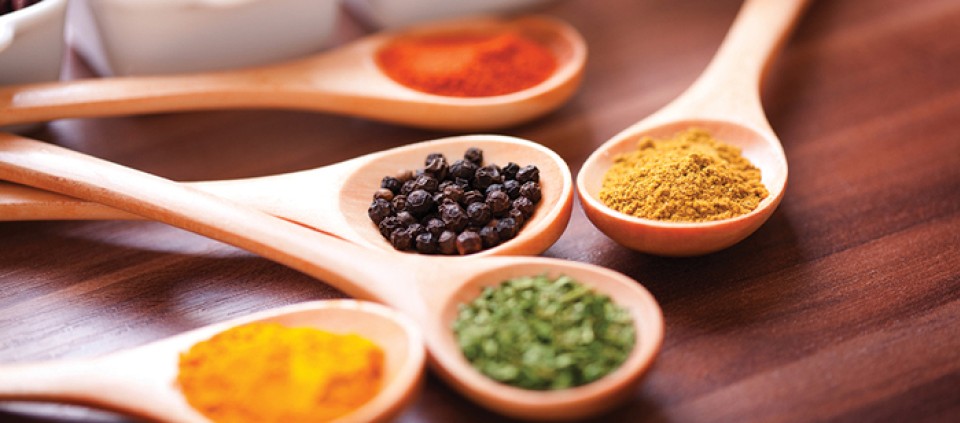Rx on Your Spice Shelf: Using Herbs as Medicine

by Brittany Wood Nickerson and Annie B. Kay
Cooking with herbs is part of an ancient tradition of using food as medicine. These everyday plants, often thought of as weeds, are wonderfully nutrient dense and have powerful healing properties. Each herb on your kitchen spice shelf has medicinal uses that go far beyond the soup pot—ranging from reducing headaches, to treating colds and flus, to relieving stress and anxiety.
Most culinary herbs and spices taste bitter, pungent, or both. Pungent herbs include cumin and turmeric, thyme and ginger, raw garlic and black pepper, as well as sage, oregano, basil, and mint. These common culinary herbs are “carminative”—they increase circulation to the digestive tract, helping to improve absorption of nutrients and relieve and prevent many common digestive discomforts.
Bitter-tasting herbs and foods stimulate the entire digestive process, starting with an increase in saliva production in the mouth. Just tasting something bitter on your tongue stimulates the secretion of digestive enzymes and acids in the stomach, bile from the liver and gall bladder, and bicarbonate from the pancreas. This helps with the breakdown of nutrients, including the digestion of fats and oils. The bitter flavor also stimulates peristalsis and encourages elimination. Consider eating a small salad of bitter greens such as radicchio, frisee, or bitter lettuces, with or before meals.
The aromatic qualities of certain herbs—such as cinnamon bark; black pepper, coriander, or fennel seeds; lavender flowers; or the leaves of mint, sage, or thyme—is due to the presence of volatile oils in the plant. Aromatic herbs are used in cooking for their unique and dynamic flavors, and their oils are anti-bacterial. Aromatic oils also help relieve tension throughout the body, including in the GI tract. They also offer aromatherapy for the body and mind: When you cook with herbs, take a minute to enjoy their scent, which can help lift your spirits and impart a sense of calm.
The accessibility of culinary herbs makes learning about their medicinal applications particularly fun and inspiring. Understanding what herbs offer reminds us of the ways that food can be (and in many cases already is) medicinal. We don’t have to search out arcane knowledge or go chasing the latest superfood to be healthy—we can continue to enjoy oregano and mint, and the basil in the pot on our windowsill. If we learn how to apply the medicinal uses of these herbs in teas and other preparations, we can expand our cooking forays into an herbal home pharmacy.
The kitchen is a place with great potential to foster well-being, not only because we create healing food and medicine there, but also because, in the moments of chopping, stirring, and creating, we can connect with ourselves and with the greater power of healing that exists in such simple acts of being and doing.
© Kripalu Center for Yoga & Health. All rights reserved. To request permission to reprint, please e-mail editor@kripalu.org.